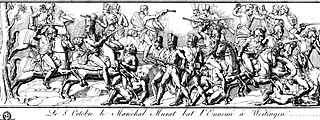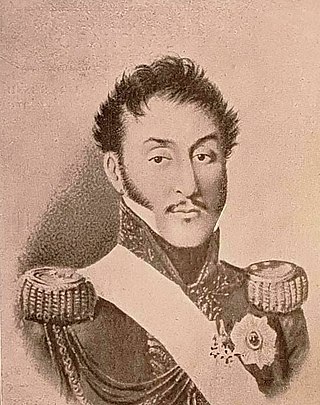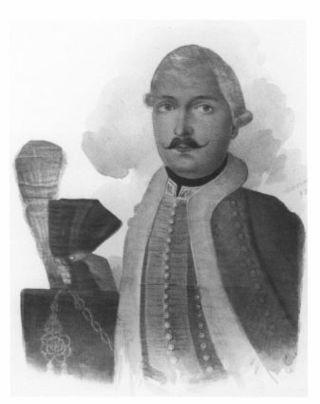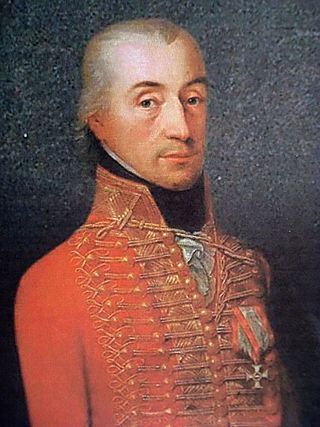
The Battle of Lodi was fought on 10 May 1796 between French forces under Napoleon Bonaparte and an Austrian rear guard led by Karl Philipp Sebottendorf at Lodi, Lombardy. The rear guard was defeated, but the main body of Johann Peter Beaulieu's Austrian Army had time to retreat. It occurred as part of the Italian Campaign of 1796–1797.

Honoré Théodore Maxime Gazan de la Peyrière was a French general who fought in the French Revolutionary Wars and the Napoleonic Wars.

The Battle of Sacile on 16 April 1809 and its companion Clash at Pordenone on 15 April saw an Austrian army commanded by Archduke John of Austria defeat a Franco-Italian army led by Eugène de Beauharnais and force it to retreat. Sacile proved to be the most notable victory of John's career. The action took place east of the Livenza River near Sacile in modern-day Italy during the War of the Fifth Coalition, part of the Napoleonic Wars.

The Battle of Tolentino was fought from 2–3 May 1815 near Tolentino, Kingdom of Naples in what is now Marche, Italy: it was the decisive battle in the Neapolitan War, fought by the Napoleonic King of Naples Joachim Murat to keep the throne after the Congress of Vienna. The battle occurred during the Hundred Days following Napoleon's return from exile and, like the Battle of Waterloo, resulted in a decisive victory for the Seventh Coalition, leading to the restoration of the previous Bourbon king, Ferdinand I.

In the Battle of Wertingen Imperial French forces led by Marshals Joachim Murat and Jean Lannes attacked a small Austrian corps commanded by Feldmarschall-Leutnant Franz Xaver von Auffenberg. This action, the first battle of the Ulm Campaign, resulted in a clear French victory. Wertingen lies 28 kilometres (17 mi) northwest of Augsburg. The combat was fought during the War of the Third Coalition, part of the Napoleonic Wars.
The Battle of Carpi took place during the Neapolitan War between a brigade of Neapolitan soldiers under the command of Guglielmo Pepe and an Austrian force under the command of Baron Frimont. The battle took place in the town of Carpi and resulted in an Austrian victory, with the Neapolitans being driven from the town.

The Battle of Casaglia was a part of the Neapolitan War. An Austrian force under the command of Johann Friedrich von Mohr engaged a Neapolitan force under their commander, Joachim Murat. The battle took place around the village of Casaglia, seven miles northwest of Ferrara, and resulted in the Austrians recapturing the village from Murat.
The Battle of Ronco took place during the Neapolitan War on 21 April 1815 in the village of Ronco, just south of Forlì. The main Neapolitan army, retreating following the disaster at the Battle of Occhiobello, was being pursued by an Austrian corps under the command of Adam Albert von Neipperg. The Neapolitans, commanded by their king, Joachim Murat, turned to check the Austrians at the Ronco River. The Neapolitans rear guard was defeated by a smaller advanced Austrian force, compelling Murat to retreat further south to the Savio River. The Austrians suffered light casualties, whereas nearly 1,000 Neapolitans were killed or wounded and more deserted Murat altogether.

The Battle of Cesenatico was a minor battle in the Neapolitan War that took place on 23 April 1815 in the town of Cesenatico on Adriatic coast.

The Battle of Pesaro was a minor battle in the Neapolitan War that took place on 28 April 1815 in the town of Pesaro.

The Battle of San Germano was the final battle in the Neapolitan War between an Austrian force commanded by Laval Nugent von Westmeath and the King of Naples, Joachim Murat. The battle started on 15 May 1815 and ended on 17 May, after the remaining Neapolitan force was routed at Mignano.

The siege of Ancona took place during the Neapolitan War. It took place beginning on 5 May 1815 and persisted until 30 May 1815. The battle took place mere days after the Battle of Tolentino on 3 May 1815.

François Xavier de Schwarz or François-Xavier-Nicolas Schwartz was born in Baden but joined the French army in 1776. He became a cavalry officer during the French Revolutionary Wars, fighting with the 2nd Hussar Regiment in numerous actions including Jemappes, Fleurus, and Neuwied. After being captured in an abortive invasion of Ireland, he was promoted to command the 5th Hussar Regiment. He led the unit in the War of the Second Coalition, most notably at Hohenlinden and in the subsequent pursuit of the Austrians.

Johann Mészáros von Szoboszló joined the Habsburg army in 1756 and fought the Prussians, Ottoman Turks, and French during a long military career. During the French Revolutionary Wars, he fought in several campaigns. He commanded a division in the 1796-1797 Italian campaign against the army of Napoleon Bonaparte. He was Proprietor (Inhaber) of an Austrian Uhlan regiment from 1792 to 1797 and a Hussar regiment from 1797 to 1801.
On 25 March 1799, French and Habsburg armies fought for control of the geographically strategic Hegau in present-day Baden-Württemberg. The battle has been called by various names: First Battle of Stockach, the Battle by Stockach, and, in French chronicles, the Battle of Liptingen. In the broader military context, this battle comprises a keystone in the first campaign in southwestern Germany during the Wars of the Second Coalition, part of the French Revolutionary Wars. For an explanation of the types of forces, please see Types of military forces in the Napoleonic Wars.

The Battle of Faenza, also known as the Battle of Castel Bolognese on February 3, 1797, saw a 7,000 troops from the Papal Army commanded by Michelangelo Alessandro Colli-Marchi facing 9,000 troops from the French Army under the command of Claude Victor-Perrin. The veteran French troops quickly overran the Papal army, inflicting disproportionate casualties. The town of Castel Bolognese was located on the banks of the Senio River 40 kilometres (25 mi) southeast of Bologna, and the city of Faenza was also nearby. The action took place during the War of the First Coalition, as part of the French Revolutionary Wars.

Vinko Knežević or Vincent Knesevich of Saint Helen ; 30 November 1755 – 11 March 1832) was a Croatian nobleman and general in the Habsburg monarchy imperial army service. He was a member of the Knežević noble family. During his long military career he fought in many battles during the Austro-Turkish War and the French Revolutionary Wars. In 1799 he led a hussar regiment at Cassano, the Trebbia and Novi. He commanded an infantry brigade at Marengo the following year and led Austrian Empire troops in the Tyrol in 1805 and at Graz in 1809. He served in various assignments on the Military Border from 1809 to 1812. From 1802 he lived on his estate Sveta Jelena in former Zala County, modern-day Međimurje County in northern Croatia. By the end of Napoleonic Wars he retired from military service as a General der Kavallerie in 1815. He became Proprietor of a dragoon regiment in 1809 and held that office until his death in 1832.

Christophe Antoine Merlin became a French division commander during the Napoleonic Wars. He joined a volunteer regiment in 1791 and fought against the Kingdom of Spain in the War of the Pyrenees. After becoming an officer in the 4th Hussar Regiment, he participated in the Rhine and Italian campaigns. In 1805 he was promoted general of brigade and fought in Italy and in the 1806 Invasion of Naples. Later he became an equerry to Joseph Bonaparte when that individual headed the Kingdom of Naples.

The Army of the Kingdom of Naples was the land force of the Kingdom of Naples. It was in service from 1806 to 1815, reborn from the Army of the Two Sicilies after the French invasion of Naples. It served alongside Napoleon’s Grande Armée in various campaigns of the Napoleonic Wars, until its final demise in the Neapolitan War.

The 1st Regiment of the Line (King's Own) or (Italian: 1° Reggimento della Linea 'del Re') was a line infantry regiment of the Royal Army of Naples. The regiment was the first infantry regiment formed by the small kingdom, but by 1811 gained a reputation as an exemplary infantry regiment, and was reformed with the honorary title of "King's Own, or del Re". After the disastrous Neapolitan War, the regiment was disbanded, having never seen action outside of the Napoleonic Wars.

















